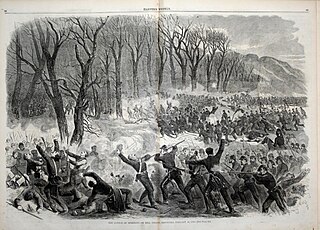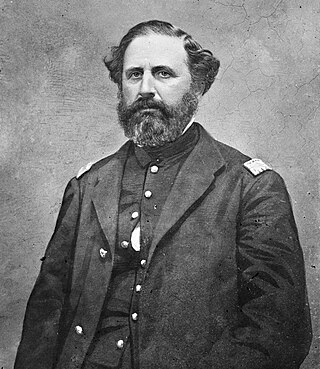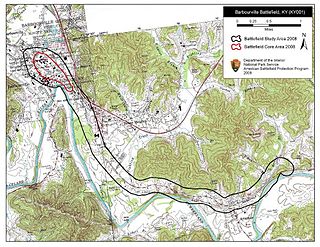Confederate Army

| Units | |
|---|---|
| Infantry |
|
| Artillery |
|
| Cavalry |
|
The following Confederate Army units and commanders fought in the Battle of Camp Wildcat (also known as Wildcat Mountain and Camp Wild Cat) of the American Civil War on October 21, 1861, in Laurel County, Kentucky. The Union order of battle is listed separately.

| Units | |
|---|---|
| Infantry |
|
| Artillery |
|
| Cavalry |
|

The Battle of Stones River, also known as the Second Battle of Murfreesboro, was fought from December 31, 1862, to January 2, 1863, in Middle Tennessee, as the culmination of the Stones River Campaign in the Western Theater of the American Civil War. Of the major battles of the war, Stones River had the highest percentage of casualties on both sides. The battle ended in Union victory after the Confederate army's withdrawal on January 3, largely due to a series of tactical miscalculations by Confederate Gen. Braxton Bragg, but the victory was costly for the Union army. Nevertheless, it was an important victory for the Union because it provided a much-needed boost in morale after the Union's recent defeat at Fredericksburg and also reinforced President Abraham Lincoln's foundation for issuing the Emancipation Proclamation, which ultimately discouraged European powers from intervening on the Confederacy's behalf.
The Confederate order of battle during the Battle of Gettysburg includes the American Civil War officers and men of the Army of Northern Virginia. Order of battle compiled from the army organization during the battle, the casualty returns and the reports.

The Battle of Richmond, Kentucky, fought August 29–30, 1862, was one of the most complete Confederate victories in the war by Major General Edmund Kirby Smith against Union major general William "Bull" Nelson's forces, which were defending the town. It was the first major battle in the Kentucky Campaign. The battle took place on and around what is now the grounds of the Blue Grass Army Depot, outside Richmond, Kentucky.

The Battle of Belmont was fought on November 7, 1861, in Mississippi County, Missouri. It was the first combat test in the American Civil War for Brig. Gen. Ulysses S. Grant, the future Union Army general in chief and eventual U.S. president, who was fighting Major General Leonidas Polk. Grant's troops in this battle were the "nucleus" of what would become the Union Army of the Tennessee.

The Battle of Mill Springs, also known as the Battle of Fishing Creek in the Confederacy, and the Battle of Logan's Cross Roads or Battle of Somerset in the Union, was fought in Wayne and Pulaski counties, near current Nancy, Kentucky, on January 19, 1862, as part of the American Civil War. The Union victory concluded an early Confederate offensive campaign in south central Kentucky.
The Battle of Salineville occurred July 26, 1863, near Salineville, Ohio, during the American Civil War. U.S. Brig. Gen. James M. Shackelford destroyed Confederate Brig. Gen. John Hunt Morgan's remaining Confederate cavalry and captured Morgan, ending Morgan's Raid. It was the northernmost military action involving an official command of the Confederate States Army.

Speed Smith Fry was a lawyer, judge, and a United States Army officer during the Mexican–American War and American Civil War.

The Big Sandy Expedition was an early campaign of the American Civil War in Kentucky that began in mid-September 1861 when Union Brig. Gen. William "Bull" Nelson received orders to organize a new brigade at Maysville, Kentucky and conduct an expedition into the Big Sandy Valley region of Eastern Kentucky and stop the build-up of Confederate forces under Col. John S. Williams. This was done in three phases. From September 21 to October 20, 1861, Nelson assembled a brigade of 5,500 Union volunteers from Ohio and Kentucky. On October 23, the southern prong secured Hazel Green and the northern prong West Liberty. The two prongs were consolidated at Salyersville and they began the final phase on October 31. This led to the Battle of Ivy Mountain on November 8 and the withdrawal of Confederate forces from Pikeville (Piketon) on November 9, 1861.

The Battle of Barbourville was one of the early engagements of the American Civil War. It took place on September 19, 1861, in Knox County, Kentucky during the campaign known as the Kentucky Confederate Offensive. The battle is considered the first Confederate victory in the commonwealth, and threw a scare into Federal commanders, who rushed troops to central Kentucky to try to repel the invasion, which was finally stopped at the Battle of Camp Wildcat in October.

Perryville Battlefield State Historic Site is a 745-acre (3.01 km2) park near Perryville, Kentucky. The park continues to expand with purchases of parcels by the Office of Kentucky Nature Preserves' Kentucky Heritage Land Conservation Fund and the American Battlefield Trust. An interpretive museum is located near the site where many Confederate soldiers killed in the Battle of Perryville were buried. Monuments, interpretive signage, and cannons also mark notable events during the battle. The site became part of the Kentucky State Park System in 1936.
In the American Civil War the Home Guard or Home Guards were local militia raised from Union loyalists.

The Camp Beauregard Memorial, outside Water Valley, Kentucky on Kentucky state road 2422 northeast of town, marks the site of a Confederate States Army encampment named for General P. G. T. Beauregard. The camp was situated to protect the right flank of the Confederate encampment at Columbus, Kentucky.

The Confederate Monument in Crab Orchard in Lincoln County, Kentucky, near Crab Orchard, Kentucky, commemorates the fallen Confederate soldiers of nearby states. Many of those buried here died at the Battle of Wildcat Mountain.
The following Confederate Army units and commanders fought in the Battle of Mill Springs of the American Civil War on January 19, 1862, near present-day Nancy, Kentucky. The Union order of battle is listed separately.
The following Union Army units and commanders fought in the Battle of Camp Wildcat of the American Civil War on October 21, 1861, in Laurel County, Kentucky. The Confederate order of battle is listed separately.
The 27th Tennessee Infantry Regiment, commonly known as the "Twenty-seventh Tennessee", was a line infantry formation of the Confederate States Army in the Western Theater of the American Civil War successively commanded by Colonels Christopher H. Williams and Alexander W. Caldwell.
The Civil War Trust's Civil War Discovery Trail is a heritage tourism program that links more than 600 U.S. Civil War sites in more than 30 states. The program is one of the White House Millennium Council's sixteen flagship National Millennium Trails. Sites on the trail include battlefields, museums, historic sites, forts and cemeteries.
The Battle of Camp Wildcat was one of the early engagements of the American Civil War. It occurred October 21, 1861, in northern Laurel County, Kentucky during the campaign known as the Kentucky Confederate Offensive or Operations in Eastern Kentucky (1861). The battle is considered one of the first Union victories of the Civil War, and marked the second engagement of troops in the Commonwealth of Kentucky.
The following Confederate Army units and commanders fought in the Battle of Jonesborough of the American Civil War on August 31-September 1, 1864. The Union order of battle is listed separately.